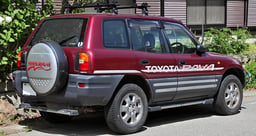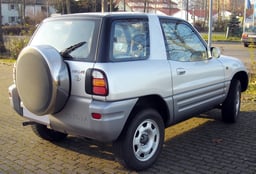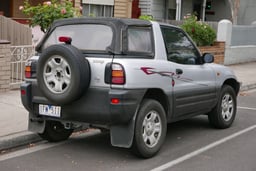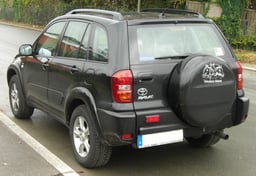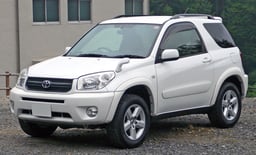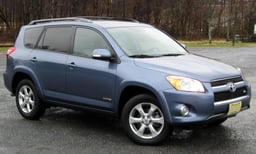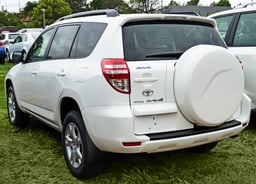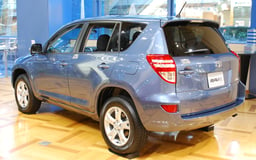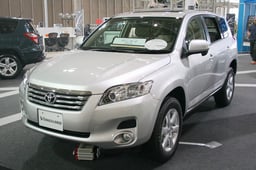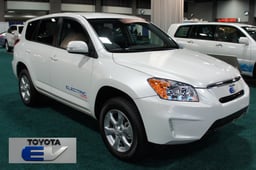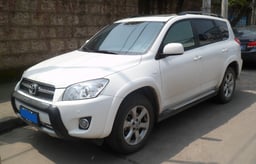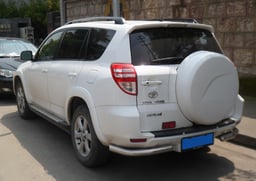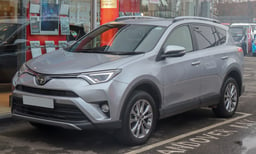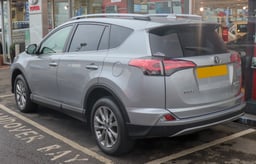Toyota RAV4
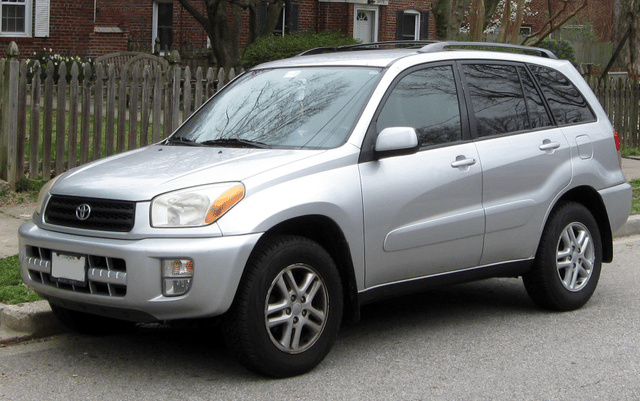
Toyota RAV4

| Toyota RAV4 | |
|---|---|
 Toyota RAV4 Hybrid (AXAH52) | |
| Overview | |
| Manufacturer | Toyota |
| Production | 1994–present |
| Body and chassis | |
| Class | Compact crossover SUV |
| Layout |
|
| First generation (XA10) | |
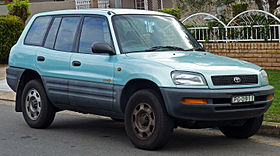 Pre-facelift Toyota RAV4 5-door (Australia) | |
| Overview | |
| Also called | Guangtong GTQ6440 (China, JV) |
| Production |
|
| Model years | 1995–2000 |
| Assembly | Japan: Toyota, Aichi (Motomachi plant; April 1994 - July 2000); Tahara, Aichi (Tahara plant; commenced January 1996)[5][6] |
| Designer | |
| Body and chassis | |
| Body style |
|
| Powertrain | |
| Engine |
|
| Transmission |
|
| Dimensions | |
| Wheelbase |
|
| Length |
|
| Width | 1,695 mm (66.7 in) |
| Height |
|
| Second generation (XA20) | |
| Overview | |
| Production | May 2000 – November 2005 |
| Model years | 2001–2005 |
| Assembly | Japan: Tahara, Aichi; Ōbu, Aichi |
| Designer | |
| Body and chassis | |
| Body style |
|
| Platform | Toyota MC platform |
| Powertrain | |
| Engine | |
| Transmission |
|
| Dimensions | |
| Wheelbase |
|
| Length |
|
| Width | 1,735 mm (68.3 in) |
| Height | 1,650–1,680 mm (65.0–66.1 in) |
| Curb weight | 1,150–1,445 kg (2,535–3,186 lb) |
| Third generation (XA30) | |
 | |
| Overview | |
| Also called | Toyota Vanguard (Japan, LWB) |
| Production |
|
| Model years |
|
| Assembly |
|
| Designer | Masaki Motozaki (exterior & interior: 2003)[18][19] |
| Body and chassis | |
| Body style | 5-door SUV |
| Platform | Toyota New MC platform |
| Powertrain | |
| Engine |
|
| Transmission |
|
| Dimensions | |
| Wheelbase | 2,560–2,660 mm (100.8–104.7 in) |
| Length | 4,395–4,620 mm (173.0–181.9 in) |
| Width | 1,815–1,855 mm (71.5–73.0 in) |
| Height | 1,685–1,755 mm (66.3–69.1 in) |
| Chronology | |
| Successor | Toyota Harrier (Vanguard) |
| Fourth generation (XA40) | |
 | |
| Overview | |
| Production | December 2012 – November 2018 |
| Model years | 2013–2018 |
| Assembly | |
| Designer | Masaki Okue, Akira Kubota and Takuya Watabe (2010) |
| Body and chassis | |
| Body style | 5-door SUV |
| Platform | Toyota New MC platform |
| Powertrain | |
| Engine | |
| Transmission |
|
| Dimensions | |
| Wheelbase | 2,660 mm (104.7 in) |
| Length | 4,661 mm (183.5 in) |
| Width | 1,845 mm (72.6 in) |
| Height | 1,660–1,705 mm (65.4–67.1 in) |
| Fifth generation (XA50)[53] | |
 | |
| Overview | |
| Production | November 2018 – present[54] |
| Model years | 2019–present |
| Assembly |
|
| Designer | Tatsuya Sonoda[55] |
| Body and chassis | |
| Body style | 5-door SUV |
| Platform | TNGA: GA-K[56] |
| Powertrain | |
| Engine |
|
| Transmission |
|
| Battery | 1.6 kW·h Ni-MH (hybrid) |
| Dimensions | |
| Wheelbase | 2,690 mm (105.9 in) |
| Length | 4,595 mm (180.9 in) |
| Width | 1,855 mm (73.0 in) |
| Height | 1,660 mm (65.4 in) |
| Curb weight |
|
The Toyota RAV4 (トヨタ RAV4 (ラヴフォー), Toyota Ravufō) is a compact crossover SUV (sport utility vehicle) produced by the Japanese automobile manufacturer Toyota. This was the first compact crossover SUV;[1] it made its debut in Japan and Europe in 1994,[2] and in North America in 1995, being launched in January 1996.[3] The vehicle was designed for consumers wanting a vehicle that had most of the benefits of SUVs, such as increased cargo room, higher visibility, and the option of full-time four-wheel drive, along with the maneuverability and fuel economy of a compact car. Although not all RAV4s are four-wheel drive, RAV4 stands for "Recreational Activity Vehicle: 4-wheel drive", because the aforementioned equipment is an option in select countries.[4]
In most markets, the RAV4 is the only compact SUV or crossover available from Toyota. In other markets, it is the crossover counterpart of the Toyota FJ Cruiser.
For the third generation model, Toyota offered both short- and long-wheelbase versions of the RAV4. Short-wheelbase versions are sold in Japan and Europe; long-wheelbase versions in Australia and North America. Toyota of Japan also sells the longer-wheelbase version as the Toyota Vanguard (Japanese: トヨタ ヴァンガード, Toyota Vangādo), at Toyopet Store locations. Japanese versions are sold at two different Toyota Japanese dealerships, the Toyota Corolla Store and the Toyota NETZ Store.
| Toyota RAV4 | |
|---|---|
 Toyota RAV4 Hybrid (AXAH52) | |
| Overview | |
| Manufacturer | Toyota |
| Production | 1994–present |
| Body and chassis | |
| Class | Compact crossover SUV |
| Layout |
|
| First generation (XA10) | |
 Pre-facelift Toyota RAV4 5-door (Australia) | |
| Overview | |
| Also called | Guangtong GTQ6440 (China, JV) |
| Production |
|
| Model years | 1995–2000 |
| Assembly | Japan: Toyota, Aichi (Motomachi plant; April 1994 - July 2000); Tahara, Aichi (Tahara plant; commenced January 1996)[5][6] |
| Designer | |
| Body and chassis | |
| Body style |
|
| Powertrain | |
| Engine |
|
| Transmission |
|
| Dimensions | |
| Wheelbase |
|
| Length |
|
| Width | 1,695 mm (66.7 in) |
| Height |
|
| Second generation (XA20) | |
| Overview | |
| Production | May 2000 – November 2005 |
| Model years | 2001–2005 |
| Assembly | Japan: Tahara, Aichi; Ōbu, Aichi |
| Designer | |
| Body and chassis | |
| Body style |
|
| Platform | Toyota MC platform |
| Powertrain | |
| Engine | |
| Transmission |
|
| Dimensions | |
| Wheelbase |
|
| Length |
|
| Width | 1,735 mm (68.3 in) |
| Height | 1,650–1,680 mm (65.0–66.1 in) |
| Curb weight | 1,150–1,445 kg (2,535–3,186 lb) |
| Third generation (XA30) | |
 | |
| Overview | |
| Also called | Toyota Vanguard (Japan, LWB) |
| Production |
|
| Model years |
|
| Assembly |
|
| Designer | Masaki Motozaki (exterior & interior: 2003)[18][19] |
| Body and chassis | |
| Body style | 5-door SUV |
| Platform | Toyota New MC platform |
| Powertrain | |
| Engine |
|
| Transmission |
|
| Dimensions | |
| Wheelbase | 2,560–2,660 mm (100.8–104.7 in) |
| Length | 4,395–4,620 mm (173.0–181.9 in) |
| Width | 1,815–1,855 mm (71.5–73.0 in) |
| Height | 1,685–1,755 mm (66.3–69.1 in) |
| Chronology | |
| Successor | Toyota Harrier (Vanguard) |
| Fourth generation (XA40) | |
 | |
| Overview | |
| Production | December 2012 – November 2018 |
| Model years | 2013–2018 |
| Assembly | |
| Designer | Masaki Okue, Akira Kubota and Takuya Watabe (2010) |
| Body and chassis | |
| Body style | 5-door SUV |
| Platform | Toyota New MC platform |
| Powertrain | |
| Engine | |
| Transmission |
|
| Dimensions | |
| Wheelbase | 2,660 mm (104.7 in) |
| Length | 4,661 mm (183.5 in) |
| Width | 1,845 mm (72.6 in) |
| Height | 1,660–1,705 mm (65.4–67.1 in) |
| Fifth generation (XA50)[53] | |
 | |
| Overview | |
| Production | November 2018 – present[54] |
| Model years | 2019–present |
| Assembly |
|
| Designer | Tatsuya Sonoda[55] |
| Body and chassis | |
| Body style | 5-door SUV |
| Platform | TNGA: GA-K[56] |
| Powertrain | |
| Engine |
|
| Transmission |
|
| Battery | 1.6 kW·h Ni-MH (hybrid) |
| Dimensions | |
| Wheelbase | 2,690 mm (105.9 in) |
| Length | 4,595 mm (180.9 in) |
| Width | 1,855 mm (73.0 in) |
| Height | 1,660 mm (65.4 in) |
| Curb weight |
|
First generation (XA10; 1994–2003)
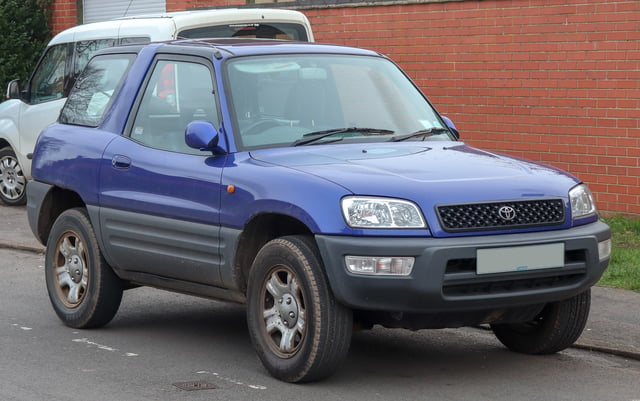
Facelift Toyota RAV4 3-door
The first generation RAV4, known as the XA10 series was constructed on a unique platform that shared Carina and Corolla elements.[9] It launched in Japan in May 1994. Design and development commenced in 1989 under code-name 153T, with design approval and start of production development in the second half of 1991 on the 3-door version and in 1993 for the 5-door version. In March 1995, the 5-door was launched and introduced to the US in January 1996, with standard dual airbags.
The XA10 series was available in both three and five door versions. In the US, a 2.0-liter straight-four producing 89 kW (119 hp; 121 PS) was available. Both front-wheel drive and all-wheel drive were available, and the RAV4 could be had with either a five-speed manual or four-speed automatic transmission. It was named the 1997 Automobile of the Year by Automobile Magazine. In 1997 for the 1998 model year, the RAV4 was slightly restyled on the front and rear fascias, and a soft top three-door was made available. Power was increased slightly to 95 kW (127 hp; 129 PS). In June 1999, the two-door hardtop was dropped from the American lineup, leaving the five-door and soft top models. In Japan, the 2.0-liter 3S-GE BEAMS engine with 132 kW (177 hp; 179 PS) was also available. Some variants of the 1998 Toyota RAV4 were labeled as SXA11 rather than XA10, paired with an owner given name of "RAV 4.1".[10]
RAV4 EV
The RAV4 EV is a plug-in, all-electric variant of the RAV4. Produced from 1997 to 2003 for fleet lease, this "zero emission" model was only offered for public sale for seven months in 2002, in very small quantities in California. Powered by an advanced Nickel-metal hydride (NiMH) battery pack capable of storing 27 kWh, the RAV4 EV can go up to 193 km (120 mi) between charges, and came with a 97,000 km (60,000 mi) battery warranty. A total of 1,484 units were leased and/or sold in California,[11] and as of mid-2012, almost 500 units were still in use.[12]
Gallery
Second generation (XA20; 2000–2005)
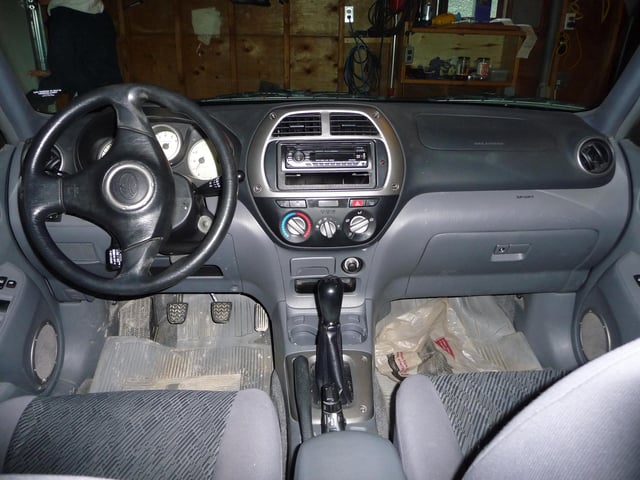
Interior
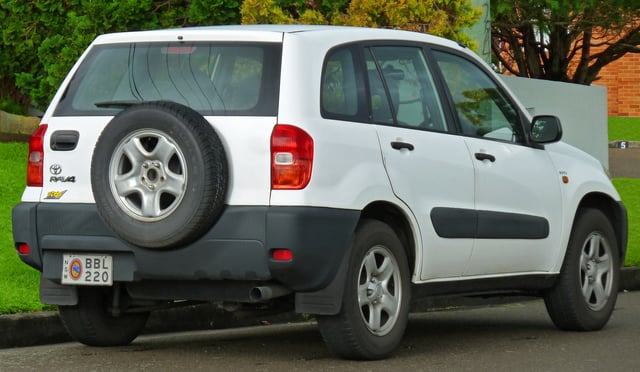
Pre-facelift Toyota RAV4 Edge (Australia)
The second generation, XA20 series RAV4 went on sale in July 2000. Like the previous model, the XA20 was available in three- and five-door configurations and was constructed on a platform that shared Carina and Corolla elements. Development began in 1995, with a design freeze in the first half of 1998. Styling was done at Calty Design Research Incorporated (also simply known as Calty) by Yasuhide Hosoda and Kevin Hunter from 1996 to 1997.[9]
The second generation RAV4 was originally offered in a number of trim levels in the UK: NV was front-wheel drive, while NRG, GX, and VX were permanent four-wheel drive with differing levels of equipment.[15] Although the RAV4 was available as a three-door in Europe, Asia and Australia, the American model was only available in a five-door configuration. A 1.8-liter inline-four engine (only with 2WD) producing 92 kW (123 hp; 125 PS), 2.0-liter inline-four engine producing 110 kW (150 hp; 150 PS), 2.4-liter inline-four engine producing 118 kW (158 hp; 160 PS), and a D-4D diesel engine were available. Some RAV4s came with anti-lock braking system, electronic stability control, air conditioning, a height-adjustable driver's seat, cruise control, a six-speaker CD stereo and power windows, mirrors and seats. A sport package added a mesh grille, bonnet scoop, color-keyed door handles, a roof rack, silver sport pedals, heated mirrors, gray-painted bumpers and fender flares, and sport fabric seats. Other options included alloy wheels, heated seats, a sunroof and keyless entry. 16-inch wheels were standard; larger tires were available on all-wheel-drive models.
In Australia, the RAV4 came in base Edge and upmarket Cruiser models in both three- and five-door configurations. The main differentiation between the two models was in appearance. Edge models came with unpainted grey bumpers and side cladding, mirrors, and door handles, and featured steel rims. Cruiser models gained body-colored (painted) bumpers and moldings, mirrors, and door handles, alloy wheels, and ABS brakes. All models came equipped with a brand-new 2.0-liter four-cylinder engine featuring VVT (variable valve timing), resulting in improved power and torque, as well as fuel consumption. Permanent all-wheel-drive was a feature. Options were ABS brakes (on the Edge), and air conditioning (on all models). The second generation RAV4 enjoyed success in Australia, where it became the best-selling SUV in the country in 2001, overtaking its rival, the Honda CR-V, for the first time.
In late 2003, the 2004 model RAV4 was given a styling update, improved equipment, and, in certain markets, a new engine. In the United States the safety structure was improved and Vehicle Stability Control made standard. The RAV4's 2.0-liter engine was upgraded with a new 2.4-liter engine in the US, producing 120 kW (160 hp; 160 PS) and 220 N⋅m (162 lb⋅ft). Other countries got mostly 5-door models with the 2.0 liter VVT-i engine. Automatic electric air conditioning also became available. European models got a new catalytic converter because of the new European emission policy. The new model also got an electric throttle.
In Australia, for the facelift, the base Edge was renamed CV, and gained standard air conditioning (previously an option). The CV also received painted bumpers, which came in either silver or body-colored shades, depending on the body color. In addition, the model range was given a subtle facelift, consisting largely of a new front bumper with circular fog lights and white turn signals instead of the older orange lights. In 2005, a new "CV Sport" model was added to the range in Australia, which included a non-functional bonnet scoop, giving the RAV4 a more aggressive appearance. The CV Sport model was short-lived, lasting only a year, and was introduced primarily to stimulate sales until the new model arrived in early 2006.
Notably, the second generation RAV4 had the highest proportion of female drivers among all makes and models in the United States with the possible exception of the Volkswagen New Beetle, according to 2003–2004 registration and survey data.[16]
Gallery
Third generation (XA30; 2005–2016)
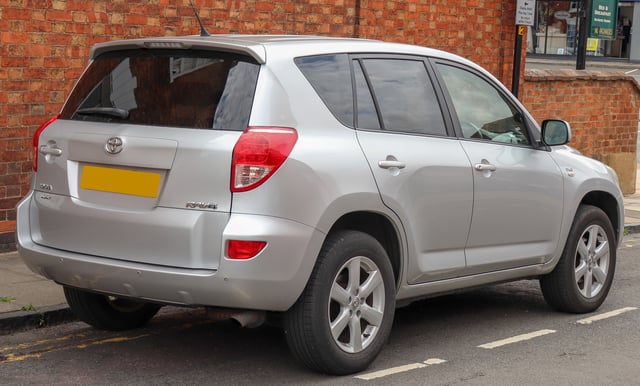
Toyota RAV4 (UK; pre-facelift)
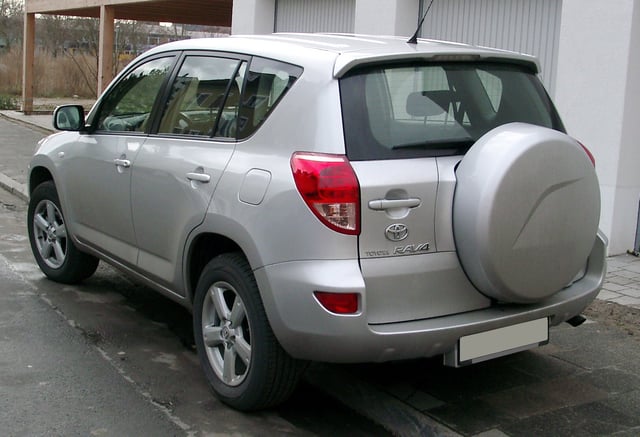
Toyota RAV4 (Germany; pre-facelift)
The Toyota RAV4 was redesigned for the 2006 model year, using an all-new platform and was first unveiled at the 2005 Frankfurt Motor Show.[20] The new RAV4 uses an Electric Power Steering (EPS) system.
The third generation RAV4 is offered in two versions: a short- or a long-wheelbase model. The short-wheelbase model is sold only in Japan, Europe and New Zealand (diesel only in NZ), with the long-wheelbase RAV4 sold in Australia, New Zealand and North America. Since 2007, the extended-length RAV4 is also sold alongside its shorter counterpart in Japan as the Toyota Vanguard, albeit with a revised front-end body work incorporating a revised grille, bumper, bonnet and headlamps.[21][22] When the larger XA40 arrived in 2012, the short wheelbase model was kept in production for the Japanese market and sold instead of the new version until 2016.
Japanese models went on sale in 2005 at Toyota NETZ dealers.[23] The 3-door was dropped in the beginning of 2007, leaving Toyota without a mini SUV until the 2009 Toyota Urban Cruiser, which is sold in Europe, North America (as the Scion xD) and Japan (as the Toyota ist).[24] The XA30 series RAV4 was sold in Japan until July 2016, where the XA40 is not to be offered. Toyota discontinued the Vanguard in November 2013 in favour of the redesigned XU60 Harrier. As the RAV4 continued to grow, it became expensive to own in Japan due to the exterior dimensions and engine displacement placing it in the upper tax bracket as defined by Japanese government dimension regulations and annual road tax obligations.
It is also the first generation of RAV4 to be offered in regular (for Asian and European markets, dropping the spare wheel from the rear) and extended (for North American and Australian markets) versions. The extended-length RAV4 is larger by 21% in interior volume from the last generation and now has an available third-row seat for children (North America and Japan only). The RAV4 can still be had in either front-wheel-drive or all-wheel-drive in North America and Japan; however most countries only sell the all-wheel-drive version.
In 2008 (for the 2009 model year) RAV4 was given a mid-cycle refresh in some markets, featuring a number of changes, including an all-new four-cylinder engine, and a redesigned front end and tweaked rear end. The Limited model gets a different front grille and bumper cover from other models. The Sport model features a bigger spoiler and red badging along with an option on the V6 model to have a rear door without the externally mounted spare tire (run-flat tires are used on this model). New features/options include turn signals integrated into the side mirrors, backup camera (with monitor built into rear-view mirror), satellite navigation, smart keyless entry, a push button starter, a multi-function instrument cluster display, etc. Much of the interior remains as before. In 2009, it was also the first time for the Canadian market to have a 2WD model sold in Canada.
In 2011 (for the 2012 model year) the RAV4 underwent another, light, facelift.
The vehicles were built in Toyota's Tahara, Aichi assembly plant, and under contract by Toyota Industries in its Nagakusa, Obu, Aichi plant. Beginning in November 2008, vehicles for the North American market were built in the Toyota Motor Manufacturing Canada Inc., Second Plant.[25][26] Beginning in March 2009, Chinese models began production by Tianjin FAW Toyota Motor Co. Ltd. in a joint-venture plant in Tianjin, China.[27]
In 2015, the XA30 series RAV4 was awarded the WheelsTV pre-owned vehicle of the year title.[28]
- Japan
Model ranges include X, G, and Sport, replacing RAV4 L and RAV4 J. The X and G can be ordered with either front-wheel-drive or AWD. The Sport model with over fenders is AWD only. The extended-length RAV4 is sold in Japan as the Toyota Vanguard, released on August 30, 2007. It is sold in five- and seven-passenger versions and slots between the regular RAV4 and Kluger. As it is often the case in Japan-only vehicles, the Vanguard comes loaded with high-tech gadgets, including steering-assisted stability control, keyless entry and satellite navigation. The Toyota Vanguard was facelifted in 2010.
- Australia
In Australia, the RAV4 is sold in four-cylinder base CV, Cruiser, Cruiser L and the limited edition "Altitude" trim levels, and CV6, SX6, and ZR6 are 6-cylinder variants. The V6 was available from 2007.
- Malaysia
In Malaysia, only the 2.0-liter automatic variant is available, in a single trim level. This model uses the 1AZ-FE four-cylinder, inline 16-valve engine with DOHC and VVT-i. The output for the 2.0-liter RAV4 in Malaysia is at 112 kW (150 hp; 152 PS) at 6,000 rpm with a torque of 194 N⋅m (143 lb⋅ft) at 4,000 rpm. It was imported from Japan and available through general importers, but not officially sold by UMW Toyota Motor.
- Middle East
In the Middle East, the RAV4 is available with a 2.4-liter engine. Most markets, including the United Arab Emirates (UAE) and Kingdom of Saudi Arabia (KSA), get the all-wheel-drive model with an automatic gearbox, but KSA additionally gets a two-wheel-drive model as well, the base one with a manual gearbox.[29]
- North America
North American models include choices of 2.4-liter 2AZ-FE inline-four or 3.5-liter 2GR-FE V6 engine. The V6 model has 201 kW (270 hp; 273 PS). In model year 2009, a slightly larger 133 kW (178 hp; 181 PS) 2.5-liter 2AR-FE inline-four replaced the previous 124 kW (166 hp; 169 PS) 2.4-liter engine. Either four-cylinder engine came equipped with a four-speed automatic transmission. The North American RAV4 with 3.5-liter 2GR-FE V6 engine is fitted with a five-speed automatic transmission. All US models feature Toyota's Star Safety System which includes Vehicle Stability Control. The new RAV4 topped Toyota SUV sales in the United States for the first time.
No manual transmission or diesel engines are available on North American models.
- Mexico
The RAV4 was first introduced in 2004; and was only available in two trim levels: Base and L. This was already an outgoing generation but still sold pretty well and both came in 2WD only and both models had, as standard equipment 16-inch alloy wheels and a roof rack. The new generation RAV4, which is the current model, had more features as standard equipment. Base and Limited trims continue to be available, but on the Limited trim 4WD became an option and the Base model now added 17-inch steel wheels but the roof rack was still standard in both trims. For the refresh of 2009 the roof rack in the Base model was eliminated as standard equipment and the Sport trim was added to the line-up. Up to 2008MY all RAV4s in Mexico had four-cylinder engines but for 2009 the Sport model became available with the V6 engine, although the four-cylinder engine was still available. The Limited trim was only available with the V6 engine and 4WD traction. For 2010, the RAV4 in Mexico has been simplified again to two trims but now the Limited trim was dropped and consequently killed the 4WD option, while the Base and Sport trims remained unchanged from 2009. The RAV4 in Mexico has experienced good acceptance since its introduction.
- China
The XA30 RAV4 commenced production in China in April 2009. Trim levels were the 2.0 Classic, 2.0 Luxury, 2.0 Luxury Navi, 2.4 Luxury and 2.4 Luxury Navi. The 2 litre 1AZ-FE and 2.4 litre 2AZ-FE were standard paired to a 5 speed manual and 4 speed automatic gearbox. Pricing ranged from CN¥ 189,800 to CN¥ 264,300 (US$26,520 to US$36,930 at the August 2019 exchange rate).
The RAV4 had different styling compared to the RAV4 in other counties where there was a black strip that was placed in between the radiator and licence plate like a moustache. It also had chrome bars below the front and rear bumpers. The licence plate was also moved to the bottom bumper area to make way for the RAV4 logo and a rear foglamp. Front and rear parking sensors are also standard.
Gallery
Body styles
| Chassis codes (DBA-A) | ACA31W | ACA36W | ACA33L | ACA37L | GSA30 | GSA33 | GSA35 | ALA30 | ALA31 | ALA36 | ZSA30 | ZSA35 |
|---|---|---|---|---|---|---|---|---|---|---|---|---|
| Drive | 4WD | FWD | 4WD | FWD | FWD | 4WD | 4WD | 4WD | 4WD | FWD | FWD | 4WD |
| Engine (Japan) | 2AZ-FE | 2AZ-FE | 2GR-FE | |||||||||
| Engine (China) | 2AZ-FE | 1AZ-FE | ||||||||||
| Engine (Europe) | 2GR-FE | 2GR-FE | 2AD-FTV | 2AD-FTV | 3ZR-FAE | 3ZR-FAE |
Engines
| Code | Years | Type/code | Power, torque at rpm |
|---|---|---|---|
| 1AZ-FE (2.0 VVT-i) | 2005–2012 | 1.998 L (121.9 cu in) (86.0×86.0mm) I4 | 112 kW (150 hp; 152 PS) at 6,000 rpm, 194 N⋅m (143 lb⋅ft) at 4,000 rpm |
| 1AZ-FE (2.0 VVT-i) | 2007MY-2008MY (UK) | 1.998 L (121.9 cu in) (86.0×86.0mm) I4 | 112 kW (150 hp; 152 PS) at 6,000 rpm, 194 N⋅m (143 lb⋅ft) at 4,000 rpm |
| 2AZ-FE | 2005–2008 | 2.362 L (144.1 cu in) (88.5×96.0mm) I4 | 124 kW (166 hp; 169 PS) at 6,300 rpm, 224 N⋅m (165 lb⋅ft) at 4,000 rpm |
| 2AR-FE | 2009–2012 | 2.494 L (152.2 cu in) I4 | 133 kW (178 hp; 181 PS) at 6,300 rpm, 233 N⋅m (172 lbf⋅ft) at 4,000 rpm |
| 2GR-FE | 2005–2012 | 3.456 L (210.9 cu in) (94.0×83.0mm) V6 | 200 kW (268 hp; 272 PS) at 6,200 rpm, 333 N⋅m (246 lb⋅ft) at 4,700 rpm |
| 3ZR-FAE (2.0 Valvematic) | 2008–2012 | 1.987 L (121.3 cu in) (80.5×97.6mm) I4 | 116 kW (156 hp; 158 PS) at 6,200 rpm, 198 N⋅m (146 lbf⋅ft) at 4,400 rpm |
| 2.0 D-4D | 2005-2006MY | 1.995 L (121.7 cu in) (82.2×94.0mm) I4 | 85 kW (114 hp; 116 PS) at 4,000 rpm, 250 N⋅m (184 lbf⋅ft) at 1,800–3,000 rpm |
| 2.2 D-4D Diesel | 2007MY-2008MY | 2.231 L (136.1 cu in) (86.0×96.0mm) I4 | 100 kW (134 hp; 136 PS) at 3,600 rpm, 310 N⋅m (229 lbf⋅ft) at 2,000–2,800 rpm |
| 2.2 D-4D Diesel 180 (UK) | 2007MY | 2.231 L (136.1 cu in) (86.0×96.0mm) I4 | 130 kW (174 hp; 177 PS) at 3,600 rpm, 400 N⋅m (295 lbf⋅ft) at 2,000–2,600 rpm |
| 2.2 D-4D, 2.2 D-CAT (UK) | 2008–2012 | 2.231 L (136.1 cu in) (86.0×96.0mm) I4 | 110 kW (148 hp; 150 PS) at 3,600 rpm, 340 N⋅m (251 lbf⋅ft) at 2,000–2,800 rpm |
| 2.2 D-CAT | 2008–2012 | 2.231 L (136.1 cu in) (86.0×96.0mm) I4 | 130 kW (174 hp; 177 PS) at 3,600 rpm, 400 N⋅m (295 lbf⋅ft) at 2,000–2,800 rpm |
RAV4 EV
Toyota worked together with Tesla Motors to develop the second generation RAV4 EV, and the electric SUV is scheduled for market launch late in the third quarter of 2012.[11][31] Production will be limited to 2,600 units during the first three years, and sales will be limited to California only, beginning with the San Francisco Bay Area, Los Angeles/Orange County and San Diego.[32][33]
The second generation RAV4 EV has a 115 kW (154 hp; 156 PS) motor powered by a 41.8kWh lithium ion battery pack, that Toyota expects to deliver a US Environmental Protection Agency rated range of 148 km (92 mi) in standard charge mode and 182 km (113 mi) in extended charge mode, for a combined range of 166 km (103 mi); and a combined fuel economy rating of 3.1 L/100 km (91 mpg‑imp; 76 mpg‑US).[12][34] The RAV4 EV battery pack and electronic components are similar to those in used in the Tesla Model S sedan launched in June 2012, because Tesla Motors is the manufacturer of the powertrain.[35]
Fourth generation (XA40; 2012–2018)
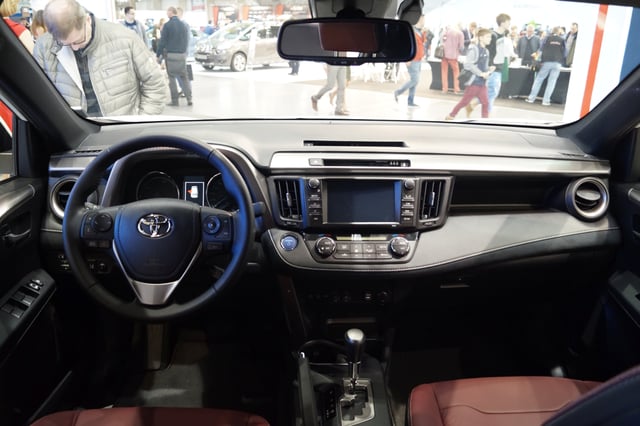
Facelift Interior
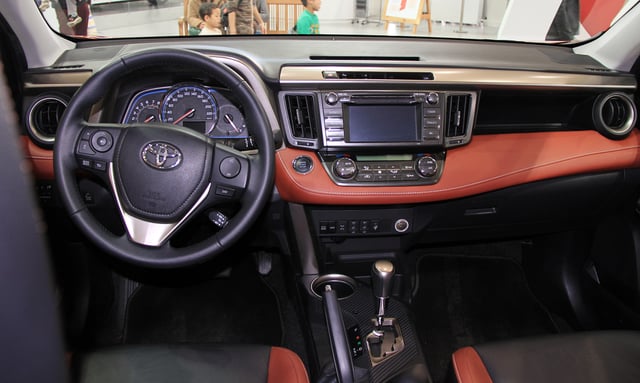
Pre-facelift Interior
The fourth generation RAV4 was a complete redesign; it was revealed at the November 2012 Los Angeles Auto Show.[40] Unlike the previous generations, it featured a rear liftgate rather than a side-opening rear door and no longer had the spare tire mounted on the rear door.
The RAV4 no longer used the V6 from the previous generation—all engine choices were inline four-cylinder engines. Also, unlike the dual wheelbase strategy employed by the previous XA30 model, the XA40 was only sold in a single wheelbase (corresponding to the long wheelbase XA30).
The full hybrid system combined a 2.5-liter Atkinson cycle gasoline engine with a powerful electric motor, a high voltage generator, a 204 cell nickel–metal hydride battery located under the rear seats, a power control unit, and a power split device. RAV4 Hybrids were available in both front and all-wheel drive variants. The all-wheel edition came equipped with a second, 50 kW high-voltage, rear mounted electric motor that offers increased traction and a 1,750-pound (790 kg) towing capacity. The rear's electric motor operates independently from the hybrid system front's electric motor, driving the rear wheels alone.[41] US sales began in early January 2013.
For the Japanese market, the previous generation in short-wheelbase length remained on sale in Japan until 2016 instead of the newer, export only, XA40. The Harrier replaced the long-wheelbase model in Japan, previously badged as the Vanguard.
In the UK and Australia, the fourth generation RAV4 went on sale in February 2013. Engine choices included a 2.0- and 2.5-liter four-cylinder gasoline, and 2.0- and 2.2-liter turbodiesels. Transmissions included a six-speed manual, Continuously Variable Transmission (CVT), and six-speed automatic.[42]
The UK model went on sale in 2013. Early European models included a choice of a 2.0-liter gasoline or one of three 2.0-liter diesel engines.[43]
The RAV4 manufactured in Woodstock, Ontario, Canada had about 50 percent of its parts coming from Japan.[44]
Production in China commenced in August 2013 and was sold alongside the XA30 model for a short time. The XA40 RAV4 in China came standard with the 2 litre 6ZR-FE and 2.5 litre 5AR-FE petrol engine. 6 speed manual, automatic and CVT gearboxes are standard. Seven trim levels were available with prices ranging from 183,800 to 272,800 yuan (25,680 to 38,120 USD).
The RAV4 was also displayed at the 22nd Indonesia International Motor Show (IIMS) in Jakarta in September 2014. It included a 2.0-liter Dual VVT-i engine with CVT transmission (with seven-speed manual mode). The facelift version was available at local import car dealers in Indonesia in 2017.
Production in Russia started in August 2016.[38]
2015 facelift
In 2015, for the 2016 model year, Toyota released a facelift for the XA40 series. The facelift debuted with the RAV4 Hybrid shown at the April 2015 New York International Auto Show. The facelift included redesigned LED front and rear lamps and updated speedometer dials with full color TFT multi information display.
Gallery
Pre-facelift styling
[[INLINE_IMAGE|//upload.wikimedia.org/wikipedia/commons/thumb/f/fb/2015_Toyota_RAV4_Icon_D4D_Automatic_2.2_Front.jpg/200px-2015_Toyota_RAV4_Icon_D4D_Automatic_2.2_Front.jpg|//upload.wikimedia.org/wikipedia/commons/thumb/f/fb/2015_Toyota_RAV4_Icon_D4D_Automatic_2.2_Front.jpg/300px-2015_Toyota_RAV4_Icon_D4D_Automatic_2.2_Front.jpg 1.5x, //upload.wikimedia.org/wikipedia/commons/thumb/f/fb/2015_Toyota_RAV4_Icon_D4D_Automatic_2.2_Front.jpg/400px-2015_Toyota_RAV4_Icon_D4D_Automatic_2.2_Front.jpg 2x||h110|w200]]
Front
[[INLINE_IMAGE|//upload.wikimedia.org/wikipedia/commons/thumb/1/1f/2015_Toyota_RAV4_Icon_D4D_Automatic_2.2_Rear.jpg/200px-2015_Toyota_RAV4_Icon_D4D_Automatic_2.2_Rear.jpg|//upload.wikimedia.org/wikipedia/commons/thumb/1/1f/2015_Toyota_RAV4_Icon_D4D_Automatic_2.2_Rear.jpg/300px-2015_Toyota_RAV4_Icon_D4D_Automatic_2.2_Rear.jpg 1.5x, //upload.wikimedia.org/wikipedia/commons/thumb/1/1f/2015_Toyota_RAV4_Icon_D4D_Automatic_2.2_Rear.jpg/400px-2015_Toyota_RAV4_Icon_D4D_Automatic_2.2_Rear.jpg 2x||h112|w200]]
Rear
Post-facelift styling
[[INLINE_IMAGE|//upload.wikimedia.org/wikipedia/commons/thumb/a/aa/2017_Toyota_RAV4_Excel_TSS_VVT-I_Automatic_2.0_Front.jpg/200px-2017_Toyota_RAV4_Excel_TSS_VVT-I_Automatic_2.0_Front.jpg|//upload.wikimedia.org/wikipedia/commons/thumb/a/aa/2017_Toyota_RAV4_Excel_TSS_VVT-I_Automatic_2.0_Front.jpg/299px-2017_Toyota_RAV4_Excel_TSS_VVT-I_Automatic_2.0_Front.jpg 1.5x, //upload.wikimedia.org/wikipedia/commons/thumb/a/aa/2017_Toyota_RAV4_Excel_TSS_VVT-I_Automatic_2.0_Front.jpg/399px-2017_Toyota_RAV4_Excel_TSS_VVT-I_Automatic_2.0_Front.jpg 2x||h120|w200]]
Front
[[INLINE_IMAGE|//upload.wikimedia.org/wikipedia/commons/thumb/a/a1/2017_Toyota_RAV4_Excel_TSS_VVT-I_Automatic_2.0_Rear.jpg/187px-2017_Toyota_RAV4_Excel_TSS_VVT-I_Automatic_2.0_Rear.jpg|//upload.wikimedia.org/wikipedia/commons/thumb/a/a1/2017_Toyota_RAV4_Excel_TSS_VVT-I_Automatic_2.0_Rear.jpg/281px-2017_Toyota_RAV4_Excel_TSS_VVT-I_Automatic_2.0_Rear.jpg 1.5x, //upload.wikimedia.org/wikipedia/commons/thumb/a/a1/2017_Toyota_RAV4_Excel_TSS_VVT-I_Automatic_2.0_Rear.jpg/375px-2017_Toyota_RAV4_Excel_TSS_VVT-I_Automatic_2.0_Rear.jpg 2x||h120|w187]]
Rear
Safety
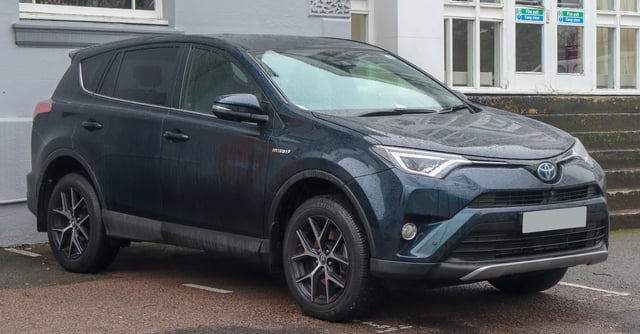
Toyota RAV4 HEV
In the Insurance Institute for Highway Safety (IIHS) evaluations, the 2013 and 2014 model year RAV4 achieved a "good" crashworthiness rating for head restraints and seats, roof strength, side, and moderate overlap front, while achieving a "poor" rating in the IIHS Small Overlap Frontal Test. Modifications were made starting in the 2015 model year which increased the small overlap front rating to "good".[47]
The small overlap test, introduced in 2012 by the IIHS, simulates a frontal collision on 25 percent of the driver's side. Since its adoption, the IIHS has noticed several automakers making non-symmetrical modifications to their vehicles, including the RAV4. Another small overlap test was conducted on a number of vehicles, including a 2015 RAV4, but was conducted on the passenger side instead. The RAV4 fared the worst and would have received a "poor" rating if the IIHS were to provide ratings for passenger-side protection. The crash test's intrusion was 330 mm (13 in) further into the vehicle on the passenger's side than on the driver's side and caused the passenger door to open during the crash.[48]
RAV4 Adventure and RAV4 Premium (2013)
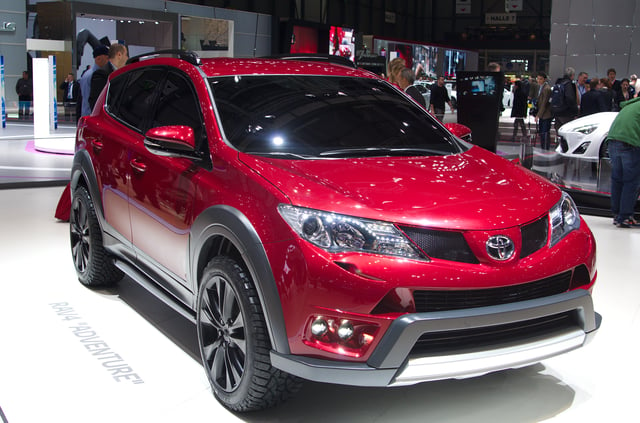
RAV4 Adventure at Geneva, 2013
The RAV4 Adventure is a concept vehicle that accentuated the car's look to reinforce its off-road capabilities. It included dark red body color, extended wheel arches, 20-inch alloy wheels and matte painted front and rear bumpers.
The RAV4 Premium is a concept vehicle with Deep Bronze body color, bumpers in Deep Bronze, chrome-finished spoiler, chrome inserts in the rear bumper, brushed aluminium skid plates, integrated tailpipe at the rear bumper, 20-inch wheels, leather interior upholstery designed by Toyota's Kansei design department, seats with black piping and V-shaped outline, two-tone double stitching and grey and black leather on the instrument panel and door panels.
A production version of the RAV4 Adventure was added to the US lineup in September 2017.[51]
Engines
| Model | Year(s) | Displacement | Fuel Type | Power | Torque | 0–100 km/h (0–62 mph) | CO2 Emissions |
|---|---|---|---|---|---|---|---|
| 2.0 FWD | 2012–2018 | 1,987 cc (121.3 cu in) | Gasoline | 111 kW (149 hp; 151 PS) | 195 N⋅m (144 ft⋅lb) | 9.9 s | 167 g/km |
| 2.0 Multidrive AWD | 2012–2018 | 1,987 cc (121.3 cu in) | Gasoline | 111 kW (149 hp; 151 PS) | 195 N⋅m (144 ft⋅lb) | 10.7 s | 166 g/km |
| 2.5 AWD | 2012–2018 | 2,494 cc (152.2 cu in) | Gasoline | 131 kW (176 hp; 178 PS) | 233 N⋅m (172 ft⋅lb) | 8.6 s | 169 g/km; 23 city/29 hwy |
| 2.5 Hybrid AWD | 2015–2018 | 2,494 cc (152.2 cu in) | Gasoline/Electric Motor | 145 kW (194 hp; 197 PS) combined | 279 N⋅m (206 ft⋅lb) combined | 8.1 s | 115 g/km; 33 city/31 hwy |
| Model | Year(s) | Displacement | Fuel Type | Power | Torque | 0–100 km/h (0–62 mph) | CO2 Emissions |
|---|---|---|---|---|---|---|---|
| 120D 4x2 | 2012–2018 | 1,998 cc (121.9 cu in) | Diesel | 91 kW (122 hp; 124 PS) | 310 N⋅m (229 ft⋅lb) | 10.5 s | 127 g/km |
| 120D AWD | 2013–2018 | 1,998 cc (121.9 cu in) | Diesel | 91 kW (122 hp; 124 PS) | 310 N⋅m (229 ft⋅lb) | 13.6 s | 136 g/km |
| 150D AWD | 2012–2018 | 2,231 cc (136.1 cu in) | Diesel | 110 kW (148 hp; 150 PS) | 340 N⋅m (251 ft⋅lb) | 9.6 s | 147 g/km |
| 150D Autodrive AWD | 2012–2018 | 2,231 cc (136.1 cu in) | Diesel | 110 kW (148 hp; 150 PS) | 340 N⋅m (251 ft⋅lb) | 10.0 s | 173 g/km |
Fifth generation (XA50; 2018–present)
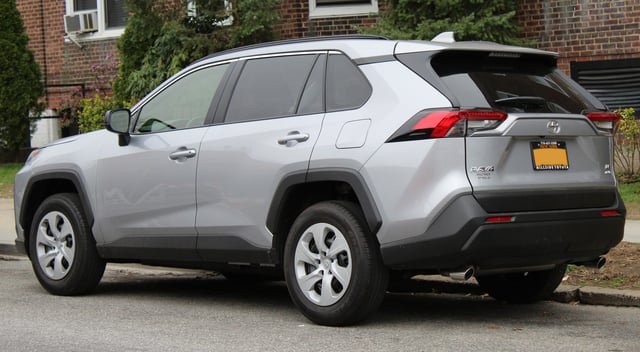
Rear view
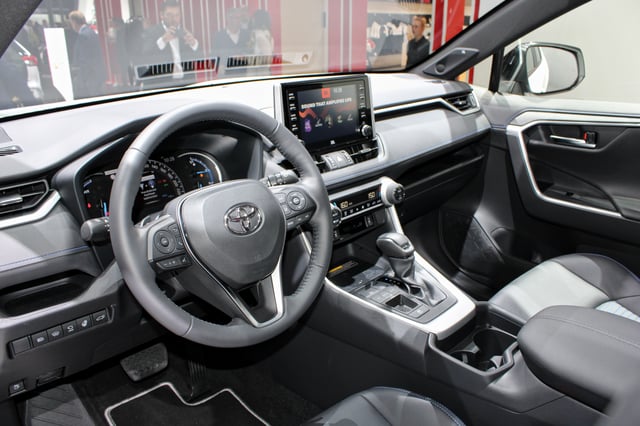
Interior
The fifth generation RAV4 debuted in March 2018 at the New York International Auto Show.[57] The design was previewed by the FT-AC concept shown at the December 2017 Los Angeles Auto Show. It is based on the front-wheel-drive Toyota New Global Architecture (TNGA-K) platform, which is also shared with eighth generation Camry, fifth generation Avalon and seventh generation Lexus ES. Both 4-cylinder gasoline-powered and gasoline-electric hybrid (Hybrid Synergy Drive) variants would remain available.
It is available in five gasoline variants which include the LE, XLE, XLE Premium, Adventure and Limited models and four hybrid variants which include the LE, XLE, XSE and Limited models. Both Adventure and Limited grades have Torque Vectoring All Wheel Drive with Rear Drive Disconnect. The engine is a 2.5L inline-4 paired with an 8-speed Direct Shift Automatic which increases horsepower by up to 15% on gasoline models. It has Multi Terrain Select providing operators an ability to maximize traction when driving on sand, mud, rock, or dirt. A 7-inch multi-touch screen is available standard with Entune 3.0, Apple Carplay, Amazon Alexa. A larger screen with JBL Audio and a Wi-Fi hotspot is optional on some trim levels. It has QI Wireless Charging with up to 5 USB Ports. Like most concurrent Toyota models, it has Toyota Safety Sense 2.0.
In the United States, the fifth generation RAV4 gasoline model is currently available since December 2018 for the 2019 model year. The hybrid model is also available since March 2019.[58]
Ireland was the first market to release the Hybrid version of the fifth generation RAV4 with delivery in late December 2018 for 2019 registration. 2WD Aura, Luna, Sol and Sport were initially available for pre-order with Platinum and AWD variants available later in 2019.
The fifth generation RAV4 was also launched in Singapore on 10 January 2019 at the Singapore Motorshow.[59]
The fifth generation RAV4 was also launched in the Philippines on 8 February 2019.[60]
The fifth generation RAV4 has been available in South Africa since March 2019 in five variants: 2.0 GX 2WD, 2.0 GX CVT 2WD, 2.0 GX-R CVT AWD, 2.5 VX CVT 2WD and 2.5 VX AT AWD. The 2.0 GX 2WD trim is also available with 6-speed manual transmission.[61]
The RAV4 was revived for the Japanese domestic market in 2019, after almost three years of hiatus that entirely skipped the fourth generation. The fifth generation RAV4 for the Japanese market was revealed on 20 February 2019 and released on 10 April 2019 at Corolla Store and Netz dealers.
The fifth generation RAV4 was released in Australia on 8 May 2019 and is available in four model grades: GX, GXL, Cruiser and Edge. The GX, GXL and Cruiser trims have two engine options: the 2.0 L gasoline and the 2.5 L hybrid, while the Edge trim has only one engine option: the 2.5 L gasoline. The GX trim is available with either 6-speed manual transmission or CVT, while the GXL and Cruiser trims as well as the GX, GXL and Cruiser hybrid variants are only available with CVT. The Edge trim is available with 8-speed automatic transmission.
In the United Kingdom, the fifth generation RAV4 is available exclusively in its hybrid version, either front-wheel driven or with all-wheel drive. It is available in four grades--Icon, Design, Excel and Dynamic.[62]
Engines
| Type | Years | Power at rpm | Torque at rpm |
|---|---|---|---|
| 1,986 cc (121.2 cu in) 2.0L M20A-FKS I4 | 2018 | 130 kW (170 hp; 170 PS) at 6600 | 203 N⋅m (150 lb⋅ft) at 4400 |
| 2,487 cc (151.8 cu in) 2.5L A25A-FKS I4 | 2018 | 154 kW (206 hp; 209 PS) at 6600 | 249 N⋅m (184 lb⋅ft) at 5000 |
| 2,487 cc (151.8 cu in) 2.5L A25A-FXS I4 (Hybrid) | 2018 | 163 kW (219 hp; 222 PS) at 5700 (Combined) | 279 N⋅m (206 lb⋅ft) at 3600 (Combined) |
Safety
In September 2019, Teknikens Värld ran both the gasoline and hybrid versions of the RAV4 on the moose test, where both vehicles failed. The testers noted "dangerous behavior" on the cone course, and that the electronic stability control "engaged very late", causing both vehicles to hop up on their outer tires multiple times during the test.[63][64]
Sales
| Calendar year | US | Canada |
|---|---|---|
| 1996 | 56,709 | |
| 1997 | 67,489 | |
| 1998 | 64,990 | |
| 1999 | 57,138 | |
| 2000 | 53,777[65] | |
| 2001 | 86,368 | |
| 2002 | 86,601[66] | |
| 2003 | 73,204 | |
| 2004 | 70,314[67] | |
| 2005 | 70,518 | |
| 2006 | 152,047[68] | |
| 2007 | 172,752 | |
| 2008 | 137,020 | 20,522[69] |
| 2009 | 149,088[70] | 25,784[71] |
| 2010 | 170,877[1] | 22,810[72] |
| 2011 | 132,237[73] | 21,550[74] |
| 2012 | 171,877[75] | 25,942[76] |
| 2013 | 218,249[77] | 33,156[78] |
| 2014 | 267,698[79] | 36,639 |
| 2015 | 315,412[80] (inc. 1,507 hybrids) | 42,246 |
| 2016 | 352,154[81] (inc. 45,070 hybrids) | 49,103[82] |
| 2017 | 407,594[83] (inc. 50,559 hybrids) | 50,894[84] |
| 2018 | 427,170 (inc. 48,124 hybrids)[85] | 55,385[86] |
